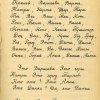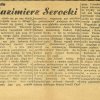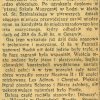In the new reality
This is to certify that citizen Serocki Józef Kazimierz is registered with us as a musician (composer - pianist). Since Serocki lost all his belongings and tools of his trade in Warsaw (flat and musical instrument), he is to be sent to his home city of Toruń or Bydgoszcz in order to practise his profession in that area. The relevant National Council is requested to allot a flat to the above mentioned citizen, if possible, and an upright piano or grand piano from the seized German belongings, as well as to provide him with general support.
Kazimierz Serocki received this document – signed by the head of the Culture and Art Department of the National Council of the city of Warsaw – on 20 February 1945. Thus, after the end of the war he went to his home city, trying to rebuild his personal and professional life in the new reality.
He took on various jobs; for instance, on 15 April 1945 he was appointed head of the music department at the State Theatre in Bydgoszcz with a salary of 1500 zlotys a month. He worked there until 15 October. At the same time he was the manager of a variety orchestra at the Office of Information and Propaganda of the Pomeranian Province, preparing concerts for hospitals, army units and civic organisations.
However, in the autumn of that year he moved to Łódź, where he resumed his musical studies. He went there, following Professor Kazimierz Sikorski, who was put in charge of the composition class at the Łódź Conservatory, later renamed the State School of Music. In addition, Serocki was seconded to the Military Scientific and Publishing Institute in Łódź, where he served as the head of the music publishing department. In order for Serocki to be able to keep his Bydgoszcz flat in 20 January Street, his employer issued him with a relevant certificate.
For the composer, the time spent studying in Łódź was very intense, filled with the sense of having to “make up for” the years lost during the war. He studied not only composition but also piano playing with Professor Stanisław Szpinalski, and diligently learned foreign languages, including English and Russian.
Most importantly, in Łódź Serocki met people who became his close friends. He and some other Szpinalski’s students – Zbigniew Szymonowicz, Bożena Matulewicz, Zofia Vogtman and Jan Krenz, the youngest of them – were “a tight bunch”. The group also included Hanna Wąsalanka, a singer and music theorist, later known as Sister Blanka, from the congregation of the Franciscan Sisters Servants of the Cross, and associated with the Education Centre for the Blind in Laski.
The bond between Szpinalski and Serocki was extraordinary; as Sister Blanka recalls, there was a “subconscious taking over of certain reactions, moves, types of behaviour” on stage, as well as a huge shared sense of humour. Its measure can be found, for instance, in Szpinalski’s saying quoted by Tadeusz Baird: “I don’t know, whether he has the tiger or whether the tiger has him, in any case there is a tiger here somewhere”, a saying he used with reference to pianists with temperaments similar to Serocki’s.
Kazimierz Sikorski, on the other hand, had high hopes for Serocki, who, as it turned out, did not disappoint him. While living in Łódź Serocki also met his future wife, Zofia Adamowska, who worked in the secretariat of the Theatre School, located in the same building as the School of Music. She was called by a diminutive name of Sonia. Her role in Serocki’s life was beautifully described by Sister Blanka:
She immediately found a place for herself in his life, she treated it as a mission. He would not have achieved what he achieved, if it hadn’t been for Sonia, who was not only a loving wife, but also a secretary, sometimes, I suspect, a mother who [...] made him work [...]. Sonia supported his goodwill. Besides, [...] he was a free man and it certainly wasn’t easy to be Kazio’s wife. He had this sense of freedom [...] and she understood this perfectly. It was an exceptional marriage, in which I saw Sonia’s beautiful, faithful friendship.
Serocki completed his musical studies in May 1946. In summer that year he became known in Bydgoszcz’s concert venues as a fine virtuoso. He gave a recital, featuring, on the one hand, works by Mozart, Beethoven and Chopin, and on the other – those by Debussy, Ravel, Szymanowski and Prokofiev, a recital enthusiastically received by the audience. He also took part in a symphonic concert, playing Schumann’s Concerto in A minor and wowing the listeners with his “virtually limitless technical capabilities”. In addition, he participated in the preliminaries of the Chopin Competition and was to go to an international competition in Geneva.
However, in August 1946 Serocki found himself in Warsaw, where he was engaged by the Municipal Drama Theatres to work as a musical illustrator and pianist. According to Tadeusz A. Zieliński, at that time Serocki was the music director of Teatr Powszechny in Warsaw. Teatr Powszechny was the first theatre opened in the capital after the war and until the late 1940s hosted the Municipal Drama Theatres. This was the period in which Serocki composed incidental music for the first time, though most of his film scores originated in the 1960s, when Teatr Powszechny was headed by Adam Hanuszkiewicz.
Initially, the composer had no permanent address in Warsaw. We know that between June 1947 and July 1948 he live at 137/2 Marszałkowska Street. At that time, thanks to Kazimierz Sikorski and Witold Rudziński, the then director of the Department of Music at the Ministry of Culture and Art, Serocki received a one-year scholarship of the French government and went to Paris to study composition with the famous Nadia Boulanger – with whom he remained in close contact till the end of her life – and piano with Lazare Lévy. However, when commenting on this stage of Serocki’s life, Zieliński notes that the composer was rather bored with the neo-classical ideals and used his scholarship stay to find (on his own) as much as possible about “the most innovative phenomena in contemporary music”, including dodecaphony and works by Béla Bartók, about which he was very enthusiastic.
While staying in France, Serocki received a notification that he had been accepted by the Polish Composers’ Union as a “candidate member”. Soon after his return, in the autumn of 1948, Serocki submitted another application, requesting (citing new achievements) to be made full (ordinary) member, but the request was not granted until 1949.
According to documents from that period, Serocki’s Warsaw address for correspondence at the time was ul. Szwoleżerów 3 [3/8 Szwoleżerów Street]. However, there is evidence to suggest that in his earliest Warsaw period he also stayed for some time in the surviving YMCA (Young Men’s Christian Association) building at 6 Konopnicka Street, where today Teatr Buffo is located. Others who stayed there included Szymon Kobyliński, Kazimierz Rudzki, Edmund Fetting and Leopold Tyrmand, promoter of the jazz movement in Poland. Perhaps it was there that Serocki had an opportunity to develop his jazz skills, especially in the fashionable swing style, skills that he nurtured during the occupation period, playing in cafes, and that are mentioned by some of the composer’s friends. As Jan Krenz says, Serocki “had a feeling for syncopation”! That the nature of Serocki’s musical interest was, at least initially, equivocal can be seen in the fact that when joining ZAIKS in 1945, he chose “light music” as his main speciality, with “classical music” being only secondary.
The events of 1949, including the composer’s participation in the memorable Congress of Composers and Musicologists in Łagów Lubuski, had – as we know – serious consequences for his further artistic development. The “creative alliance” with Jan Krenz and Tadeusz Baird in “Group 49” was built on friendship and willingness to help each other. But these relations were also deeply personal, human.
http://www.polona.pl/dlibra/doccontent?id=22767&from=FBC
http://www.polona.pl/dlibra/doccontent?id=22765&from=FBC
http://www.polona.pl/dlibra/doccontent?id=22764&from=FBC
At that time Serocki’s main activity was still piano playing – the composer was involved in the promotion of works of all three group members. It seems that he performed as a pianist for the last time in 1951, playing his own Romantic Concerto. After that he abandoned the piano entirely in order to devote himself to creative work, which became his idée fixe.
The first half of the 1950s was in any case a period of hard work for Kazimierz Serocki, as he steadily built his position in the musical circles. He wrote and performed his works, travelled abroad, pursued the career of a film music composer (e.g. writing music to the blockbuster film Chopin’s Youth directed by Aleksander Ford). As a member of the Polish Composers’ Union, Serocki became very involved in the activities of the organisation. Already in 1950 he became a member of the Union’s management as its secretary general. Between 1951 and 1954 he was a member of the PCU Board, and in 1954-55 (after the 7th General Assembly on 24-26 April 1954) he served, alongside Tadeusz Baird and Andrzej Panufnik, as deputy president. The Union’s President at the time was Kazimierz Sikorski.
Minutes and notes from General Assemblies of the PCU testify to Serocki’s involvement in nearly all matters discussed during those meetings. The biggest undertaking in which he took part was undoubtedly the Polish Music Festivals (1951 and 1955) – huge events planned as showcases for the achievements of Polish composers, especially living composers, who were to be presented to a wider audience.
It is commonly believed that the “role of his life” was that of the initiator, together with Tadeusz Baird, of the International Festival of Contemporary Music in Warsaw (known since 1958 as the “Warsaw Autumn”). However, the context and circumstances in which the Festival was inaugurated are too more complex for Serocki to be automatically called its “father”. The fact is that during the 8th General Assembly of the Polish Composers’ Union, in June 1955, Serocki and Baird signed a recommendation urging
the future Board of the PCU to immediately start talks with state authorities, first of all the Ministry of Culture and Art and the Committee for International Cultural Cooperation, about the organisation of permanent Music Festivals under the name of “WARSAW MUSICAL AUTUMN”.
Archive sources also show that the idea for the new festival stemmed from the experiences of the Polish Music Festivals and its main goal was to “compare contemporary Polish music with that of other nations”. When the document quoted above was being signed, the matter of the “Warsaw Musical Autumn” was already at an advanced stage of arrangements with the authorities, arrangements which also included the date (set for early autumn 1956). Moreover, although the initiative came from the two young composers, many more people were instrumental in its implementation (Bacewicz, Dobrowolski, Kotoński, Jarociński); this applies also to the then President of the PCU, Kazimierz Sikorski, who obtained a positive decision on the matter of the festival in a personal interview with Bolesław Bierut, President of Poland at the time, during a reception at the Belweder Palace, probably in 1954.














